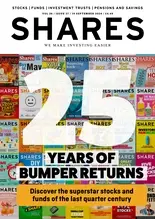
One of the biggest questions you must ask before you put capital to work in the financial markets is this: Is the investment worth the risk? Any portfolio pick brings some element of danger with it, related to its country or industry of operation, the quality of the staff and management and the soundness of its finances. Shareholders, therefore, should target a reasonable rate of return to match the risks they are running when they entrust their hard-earned cash to a company.
Total shareholder return (TSR) is generated either through dividend payments, capital gains or a combination of the two. Being aware of the risks you are taking to bag the shareholder distribution or share price increases is vital.
If, for example, your analysis of the stock?s valuation and dividend yield suggests it can provide a meagre 3% annual total return it might be better to look elsewhere, even the bank. Headline interest rates have been stuck at 0.5% since Gordon Brown was prime minister, but savings are guaranteed by the government up to £85,000 if a bank falls into financial trouble. As an equity investor you are last in the pecking order of creditors in the event of a corporate failure and thus likely to get nothing. It is precisely this risk which means you must seek premium returns from stocks to compensate you for the potential pitfalls involved.
(Click on image to enlarge)
The risk business
The best way of identifying a suitable risk/reward profile is to look at the asset classes open to investors and to rate how relatively secure, or dangerous, they are. The table below provides as a framework for how you might go about this, although this is not meant to be prescriptive. Only you can judge what your idea of a risk and a satisfactory reward is.
The basis for the calculation is based on the yield on a government bond. In principle this is risk-free. The government will return your initial investment, or principal, upon maturity of the debt and in the meantime pay the coupons and provide you with interest. Failure to do so is known as a default and is very rare, despite this month?s shenanigans in the USA. Britain has not welshed on its creditors since the Stop of Exchequer under Charles II in 1672, not least because the Bank of England can always print money if it needs to. As such lending a government money is seen as a safe option, although critics of quantitative easing (QE) would question this, given the potential impact upon returns in inflation-adjusted, real rather than stated, nominal terms.
Note our framework uses a 3% yield for the UK ten-year bond. QE has driven this down to 2.77% at the time of writing, as if to show how the policy forces investors to take more risk in exchange for potentially less return. If the bond yield slides to 2% but the relationships remain the same, investors will be happy to get just 5% to 6% from junk bonds and 9% from food retailers, even though the operational risks associated with the underlying stocks are no different. This also helps explain what could happen as and when QE ends: if bond yields rise, investors will demand higher returns on a relative basis from other asset classes and you can only get those if their valuations fall and your entry point price is lower. In other words, yields up, equities down is a possible scenario and one to which the summer and autumn ?taper tantrums? give a firm hint.
Note also this example explains the concept of the ?equity risk premium,? a phrase you will hear strategists bandy about. It is generally assumed this runs at some 4% to 7% above the risk-free rate but this will shrink in bull markets as investors become more confident and rise in bear ones as fear replaces greed.
Know thy self
Speciality pharmaceutical Plethora Solutions (PLE: AIM) is an interesting case study for a stock. In June the company had yet to generate its first pound of revenue and invested all of its cash to get its premature ejaculation product approved, so all was looking grim. Its shares languished at 2.4p. Anyone even contemplating an investment here knew that the stock could have easily gone to zero so any returns had to be huge to compensate for that ghastly prospect - after all, risk is best defined as permanent loss of capital. In this case, positive feedback from the regulator on the treatment and a balance sheet-boosting placing helped the shares rocket to 11.1p by the time of writing. Broker Hybridan believes launch in just five EU countries could generate sales of £48 million, well in excess of the current £40.7 million market cap and six times the valuation given by the market in June. It is an extreme example but it shows how even in these situations it is possible to judge the three key risks associated with any company or investment:
? Market risks. These fall outside of management?s control, such as interest rates rises, inflation and general economic conditions, or even a stock market crash.
? Company risks. These are issues specific to the sector or individual firm. The issues to address here include competition for market share, pricing, barriers to entry, management competence and financial strength.
? Financial risk. Debt is a killer. Interest payments suck away cashflow that could otherwise be invested in the core business to make it stronger and high debts mixed with weak cashflow can lead to disaster and bankruptcy in a worst case, and thus a nasty portfolio loss.
Your appetite for risk is yours to decide and yours alone. To assess how much risk you wish to take before putting your hard-earned cash to work there are four questions you need to answer:
? Why am I investing?
? What is my time horizon?
? What target return would I like to make?
? What is my appetite for risk?
The answers to these questions will you form a risk/reward profile and help you to assess what is a reasonable return from your portfolio strategy. They will also shape your preferences by asset class, sector and type of stock, according to the risk/reward profile that all starts back with those reputedly ?risk-free? government bonds.
This is an edited version of an article that was first published by Shares in October 2013.






